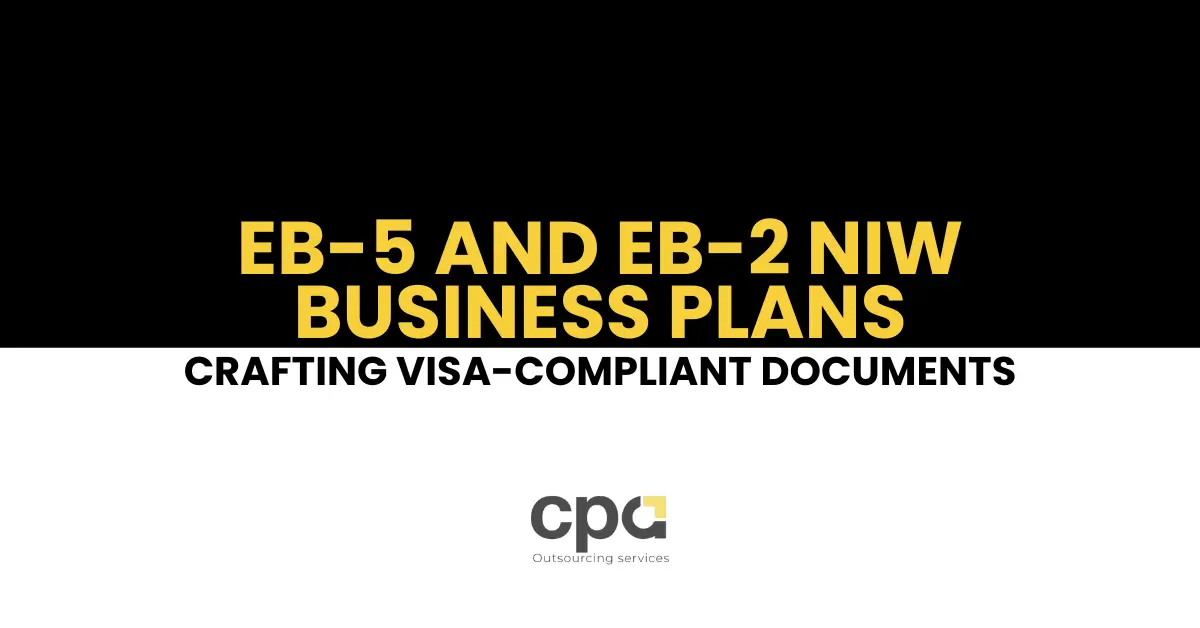EB-5 and EB-2 NIW Business Plans: Crafting Visa-Compliant Documents

Immigrating to the United States through business or investment visas is a path that many entrepreneurs and professionals pursue. But if there’s one thing that can make or break your application, it’s the business plan. Whether you’re applying through the EB-5 Immigrant Investor Program or the EB-2 National Interest Waiver (NIW), your plan must go beyond standard business documents. It has to be visa-compliant, meeting the very specific requirements set by the U.S. Citizenship and Immigration Services (USCIS). In this guide, we’ll walk you through the essentials of crafting an EB-5 business plan and an EB-2 NIW plan that not only support your visa application but also demonstrate the credibility of your business idea.
Why Business Plans Matter in Immigration
In most visa categories, a business plan is more than a formality it’s evidence. It shows USCIS officers that you’re serious, prepared, and that your proposed enterprise or project benefits the U.S. economy. A well-prepared EB-5 business plan or EB-2 NIW plan is often the deciding factor in whether your petition is approved. Think of it as your story told in numbers, strategy, and compliance language.
Understanding the EB-5 Business Plan
The EB-5 visa is designed for immigrant investors who put capital into a U.S. enterprise and create jobs for American workers. An EB-5 business plan must prove that the investment is legitimate, sustainable, and compliant with USCIS guidelines. It’s not enough to say you’ll invest $800,000 or $1,050,000 you must show exactly how that money will be used to create at least 10 full-time jobs.
Key Components of an EB-5 Business Plan
Here’s what every EB-5 business plan should include:
- Company Overview: Explains the nature of the business, structure, and ownership.
- Market Analysis: Provides data on industry trends and customer demand.
- Job Creation Strategy: Details how the investment will result in 10 full-time U.S. jobs.
- Financial Projections: Includes revenue forecasts, cash flow, and break-even analysis.
- Operational Plan: Explains timelines, milestones, and management roles.
For example, if an investor plans to open a hotel in Florida, the EB-5 business plan would need to outline how many employees will be hired, what roles they’ll fill, and how the hotel will generate enough revenue to sustain them.
Understanding the EB-2 NIW Plan
The EB-2 NIW (National Interest Waiver) is different from the EB-5 program. It’s designed for professionals whose work is in the national interest of the U.S. The EB-2 NIW plan doesn’t focus on investment dollars but instead highlights how your skills, business, or project benefit the country in areas like healthcare, technology, or education.
Key Components of an EB-2 NIW Plan
Every EB-2 NIW plan should demonstrate three things: substantial merit, national importance, and your ability to execute the project. Here’s what to include:
- Professional Background: Your education, experience, and expertise.
- Project Description: What you plan to do and how it benefits the U.S.
- National Impact: Evidence that your work addresses critical U.S. needs.
- Implementation Strategy: Timelines, resources, and partnerships.
- Financial Viability: Proof you have the means to carry out your plan.
For example, a medical researcher applying for an EB-2 NIW visa might prepare a plan showing how their research into affordable cancer treatments has national impact. The EB-2 NIW plan would include data on cancer statistics, details of their research, and how their work aligns with U.S. public health goals.
Compliance with USCIS Standards
Both EB-5 business plans and EB-2 NIW plans must meet strict compliance requirements. USCIS looks for credible, well-documented plans backed by data. Unsupported claims or vague projections are red flags. Compliance means aligning your business plan with Matter of Ho, a landmark precedent decision that sets standards for EB-5 business plans, and the policy guidance for EB-2 NIW petitions.
Common Mistakes to Avoid
Even strong applicants sometimes fail because of weak business plans. Avoid these pitfalls:
- Overly optimistic financial projections without data support.
- Job creation claims in EB-5 plans without clear staffing plans.
- EB-2 NIW plans that lack proof of national importance.
- Generic templates that don’t address USCIS requirements.
Real-World Examples
A foreign investor once submitted an EB-5 business plan for a chain of restaurants without detailing how jobs would be created or sustained. The application was denied. Later, with a revised EB-5 business plan showing detailed hiring plans and revenue forecasts, the project gained approval.
Similarly, an engineer applying for an EB-2 NIW initially submitted a vague proposal. After working with consultants to create a detailed EB-2 NIW plan that demonstrated how his work would improve U.S. infrastructure, his petition was approved.
Why Work with Experts?
Crafting visa-compliant documents isn’t easy. It requires knowledge of both business strategy and immigration law. Partnering with professionals who specialize in EB-5 business plans and EB-2 NIW plans ensures your documents meet USCIS standards and stand out from generic submissions.
Final Thoughts
Whether you’re an investor creating an EB-5 business plan or a professional preparing an EB-2 NIW plan, the key is compliance, clarity, and credibility. Your business plan is more than paperwork it’s the foundation of your visa application. Done right, it can open doors to permanent residency in the United States and help you launch your career or business with confidence.
